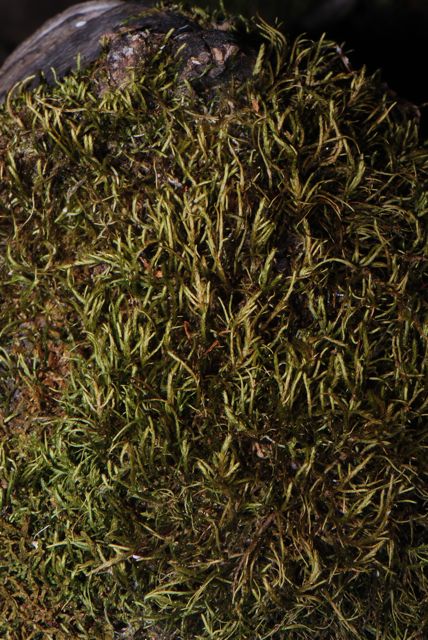Trans. Amer. Phil. Soc. 13: 11. 1864.
Plants in loose mats, olive-green to dark green or (in exposed sites) with a red-brown cast, irregularly branched to regularly pinnate with many of the branches flagelliform. Primary stems short and prostrate with secondary stems julaceous, to 10 cm long, decumbent to somewhat ascending. Leaves to 3.0 mm, 2–4:1, symmetric and straight, concave and smooth to weakly plicate, ovate to ovate-lanceolate, imbricate but with a deflexed, often curled, narrowly acuminate apex. Margins strongly and evenly recurved nearly to apex, decurrent at base, usually serrulate to occasionally nearly entire in the proximal two-thirds but typically sharply dentate at the apex. Serrations of leaves composed mostly or entirely of wall material, often obscurely binate. Median cells smooth. rhomboidal, typically vermiculose with dumbbell-shaped end walls, 4–6 µm wide, 3–6:1, not much pitted. Basal cells somewhat longer, pitted especially near the costa. Alar cells quadrate to transversely elongate, thick-walled, extending nearly to costa and an equal distance up the margin, grading into laminal cells. Apical cells typically coronate-papillose with some adjacent cells lightly prorate. Costa extending about 4/5, flattened and broadened with some forking at the leaf insertion. Pseudoparaphyllia orbicular, tightly overarching the bud. Axillary hairs to 100 µm, 5–6 celled with two basal brown cells. Rhizoids red-brown, smooth, to 8 µm in diameter, clustered on the expanded abaxial costa base and sometimes on adjacent portions of the stem.
Dioicous with male plants typically somewhat smaller than the females. Perigonia nearly spherical, bud-like, densely cloaking the stem and large branches. Perichaetial leaves 4–6 mm long, ecostate, strongly convolute around the seta, abruptly acuminate from an ovate base. Seta 5–10 mm long, erect, exserted. Capsule brown, symmetric and erect, not distorted or sulcate when dry. Urn to 4.5 mm, 4–5:1. Exothecial cells irregular in size and shape, 15–30 µm wide, 1–5:1, with elongate cells typically alternating with shorter cells in vertical rows. Operculum conic, about 1/4 as long as urn. Exostome teeth narrowly lanceolate, about 10:1, strongly papillose, white, erect when dry. Endostome segments very narrow, about half as long as exostome and with no basal membrane. Spores papillose, 18–22 µm.
Antitrichia californica is endemic to the west coast of North America where it is found from southern California to the north coast of British Columbia. It is mostly a plant of rather hot and dry forest types, especially oak forests. As such its eastern range includes Idaho, Montana and Nevada as well as the strictly coastal states and provinces. This plant is distinguished by its narrowly and evenly recurved margins, its reflexed acumen, and the strongly julaceous habit. The coronate-papillose apex is best seen on the especially narrowly acuminate apices of the apical leaves of smaller branch stems, and this character is shared only with Antitrichia curtipendula -- a plant limited to extreme coastal sites in California. Sometimes small and poorly developed specimens of the latter species may be confused with A. californica but the pale stem and branch apices and the falcate leaves of A. curtipendula are distinctive even here.
| Literature | Bourell 1981; Bradshaw 1926; Harpel 1980a; Harthill et al. 1979; Holmberg 1969; Kellman 2003; Kingman 1912; Koch 1950a, 1951e, 1958; Koch and Ikenberry 1954; Lawton 1971; Lesquereux 1868; Long 1978; McCleary 1972; Millspaugh and Nuttall 1923; Mishler 1978; Sayre 1940; Shevock and Toren 2001; Showers 1982; Spjut 1971; Steere 1954; Thomson and Ketchledge 1958; Toren 1977; Watson 1880; Whittemore and Sommers 1999; Yurky 1990, 1995. As Antitrichia californica var. ambigua Renauld and Cardot 1890. |
| Illustrations | Malcolm et al. 2009 p. 303; Lawton 1971. |
| Bioregions | CaR, CW, MP, NW, SN, SW. |
| Vouchers | Lake Co.: Clear Lake State Park, Norris 47721; Modoc Co.: Boles Creek southeast of Clear Lake, Norris 79170; Monterey Co.: Nacimiento-Ferguson Road at boundary of Hunter-Liggett Military Reservation, Norris 87344; Orange Co.: Silverado Canyon, Cleveland National Forest, Shevock 3995; Shasta Co.: Fall Creek Road at Dekkas Rock above Lake Shasta, Shasta-Trinity National Forest, Norris 84814; Tulare Co.: Wishon Fork Tule River above Wishon Campground, Sequoia National Forest, Shevock & Morosco 16802. |
| keyimagelink(25%) | http://herbaria4.herb.berkeley.edu/drawings/AnCaNorris8242.gif caption: drawing by Montalvo of Norris 8242 |
·
![University of California [UC]](http://ucjeps.berkeley.edu/common/images/logo_uc_80.png)
![University of California [UC]](http://ucjeps.berkeley.edu/common/images/logo_uc_80.png)

